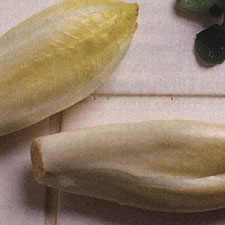
FoodFood InformationVegetablesBitter Greens
Belgian endive (witloof chicory) is probably our most aristocratic and
costly salad green. It used to be available only during the cooler months,
but now that it is flown in via jet, it is available year-round. However,
it is more costly and not quite as fine in quality during the summer months.
Nearly all the Belgian endive sold in the United States is grown in Belgium.
An insignificant amount is imported from Chile during the summer months,
but very little, if any, Belgian-type endive is grown domestically. During
World War II some was grown in Michigan, but the product was below par and
was discontinued at the end of the war.
Belgian endive dates back only to the mid-nineteenth century. It was discovered
by accident by a Belgian farmer who had stored then forgotten some chicory
roots in his barn to use as fodder. Some time later, while gathering the
chicory roots to feed his pigs, he noticed that some of
them had sprouted crisp white leaves. He tasted the leaves, and what is
now a multimillion-dollar industry was thus born.
The word endive in Belgian endive is a misnomer. In Europe it is properly
called witloof chicory. (Witloof in the Flemish tongue means white leaf.)
The Belgian endive is produced by forcing the roots of the chicory plant,
not unlike the way people force blossoms from forsythia or other flowering
shrubs. Few Americans are aware of the laborious, painstaking process that
is required to coax the chicory root to produce this elegant salad green.
The Belgian endive is produced by hand labor without the aid of any farm
machinery other than a spade or a hoe.
The Belgian farmer can't go to his seed store and order Belgian endive seeds
because there is no such animal. He has to start off with seeds of the chicory
plant. These seeds are sown by hand, and after about six weeks the chicory
plants have roots that resemble thin white carrots. The plants are carefully
dug up, the tops are removed, and the roots are planted indoors under mounds
of sand and soil. These mounds provide the warmth, humidity, and total darkness
required to force the roots to sprout. When the roots eventually sprout
the desired white, tightly compacted leaves, they are again dug up and transplanted
to beds of loam. After several weeks the cylindrical shaped, white leafed
sprouts, are gathered, washed, graded, and carefully packed in 10 pound
cartons. This tedious hand-labor process can't be speeded up, but once the
endive is ready to ship, it is rushed to the large markets in a matter of
hours.
Since as little as a single head of endive, one fifth or one fourth of a
pound, goes a long way in a mixed salad, its high cost per pound is not
prohibitive. When served alone, or when baked or braised and served as a
hot vegetable, it is a luxury item.
When purchasing Belgian endive, look for firm, plump, crisp, unblemished,
pure white heads that have yellow leaf tips. If those tips are green rather
than the desired yellow, the endive isn't fresh and will taste very bitter.
The short, fat heads are preferable to those that are long and thin.

Deamer 5/97